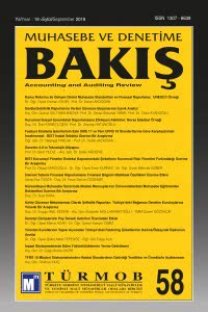KAYNAK TÜKETİM MUHASEBESİ KAPSAMINDA ÜRÜN MALİYETLERİNİN TESPİTİ: DİJİTAL BASKI İŞLETMESİNDE BİR UYGULAMA
Atıl Kapasite Maliyetleri, Faaliyet Tabanlı Maliyetleme Yöntemi, Kaynak Tüketim Muhasebesi
DETERMINATION OF PRODUCT COSTS BASED ON RESOURCE CONSUMPTION ACCOUNTING: AN APPLICATION IN DIGITAL PRINTING BUSINESS
___
- Abbas, K. M. (2015). Viability of some applied cost systems in manufacturing firms: Egypt's case (April 3, 2015). Scientific Papers Series Management, Economic Engineering in Agricultural and Rural Development, Bucharest, Romania,15(1):11-17, Erişim Adresi: https://ssrn.com/abstract=2589678.
- Akpınar, Y. (2020). Sürekli iyileştirme-geliştirme anlayışıyla kaynak tüketim muhasebesi: Bir uygulama (Yayımlanmamış doktora tezi). Kahramanmaraş Sütçü İmam Üniversitesi, Sosyal Bilimler Enstitüsü, Kahramanmaraş.
- Aktaş, R. (2013). Yeni bir maliyet ve yönetim muhasebesi yöntemi olarak kaynak tüketim muhasebesi. Muhasebe ve Finansman Dergisi, 58, 55-76.
- Al-Hebry A.A. ve Al- Matary, E.M. (2017). A critical study of cost approaches in the accounting thought: Conceptual study. International Review of Management and Marketing, 7(3), 105-112.
- Ahmed, S.A. ve Moosa, M. (2011). Application of Resource Consumption Accounting (RCA) in an educational institute. Pakistan Business Review, 12(4), 755-775.
- Basık, F. O. (2012). Rekabet stratejisinde maliyet yönetimi. İstanbul: Türkmen Kitabevi.
- Boyar, E. ve Güngörmüş, A. H. (2006). TMS-2 stoklar standardında maliyet yöntemi ve bir uygulama önerisi. Analiz, 7(16), 83-91.
- Büyükmirza, H.K. (2016). Maliyet ve yönetim muhasebesi (21. Baskı). Ankara: Gazi Kitabevi.
- Gökçen, G. ve Öztürk, E. (2017). Tam maliyet ve normal maliyet yöntemlerinin UFRS (TFRS) ve BOBİ FRS’deki düzenlemeler çerçevesinde incelenmesi. Finans Ekonomi ve Sosyal Araştırmalar Dergisi, 2(2), 105-114.
- Gurowka, J. ve Lawson, R.A. (2007). Selecting The right costing tool for your business needs. Journal of Corporate Accounting & Finance, 18 (3), 21-27.
- Hansen, D. R., Mowen, M. M. ve Guan, L. (2009). Cost management: Accounting & Control (6. Baskı). ABD: Cengage Learning.
- Hiçyorulmaz, E. ve Akdoğan, H. (2019). Kaynak tüketim muhasebesi ve endüstri 4.0’ın üretim işletmeleri üzerindeki etkisi. Ankara: Siyasal Kitabevi.
- Horngren, C. T.,Datar, S. M.ve Rajan, M. V. (2012). Cost accounting: A managerial emphasis (14. Baskı). New Jersey: Pearson Prentice Hall.
- Inanlou, I., Hassanzadeh, M. ve Khodabakhshi, N. (2014). Evaluating the cost of resources consumed in the main activity of Iran Khodro, Singaporean. Journal of Business Economics and Management Studies, 2, 199-204.
- Karaca, N. ve Küçük, H. (2017). Kaynak Tüketim Muhasebesi Temelinde Ürün Maliyetlerinin Hesaplanması- Karşılaştırmalı Bir Uygulama, İşletme Araştırmaları Dergisi, 9(2), 353-375.
- Köse, T. ve Ağdeniz, Ş. (2015). Kaynak tüketim muhasebesinde kapasite maliyet yönetimi. Muhasebe ve Denetime Bakış Dergisi, 15(45), 51-74.
- Kurtlu, A.E. (2016). Kaynak tüketim muhasebesi: silah fabrikası örneği. Niğde Üniversitesi İktisadi ve İdari Bilimler Fakültesi Dergisi, 9(3), 1-14.
- Okutmuş, E. (2015). Resource consumption accounting with cost dimension and an application in a glass factory. International Journal of Academic Research in Accounting, Finance and Management Sciences, 5(1), 46-57.
- Öğünç, H. ve Tekşen, Ö. (2018). Kaynak tüketim muhasebesi yaklaşımının tuğla üretim işletmesinde uygulanması ve karşılaştırmalı analizi. Muhasebe Bilim Dünyası Dergisi, 2, 389-417.
- Öncel, M. ve Büyükmirza, H.K. (2019). Kaynak tüketim muhasebesinin müşteri kârlılık analizinde kullanılması: Bir üretim işletmesinde uygulama. Ünye İİBF Dergisi, 2(2), 18-41.
- Özyapıcı, H. (2012). Resource consumption accounting and its application in a healthcare institution (Yayımlanmamış doktora tezi). Çukurova University, Institute of Social Sciences, Adana.
- Pehlivan, A. ve Gerekan, B. (2013). Türkiye muhasebe ve finansal raporlama standartlarına göre değerleme. Trabzon: Celepler Matbaacılık Yayın ve Dağıtım.
- Perkins, D. ve Stovall, O.S. (2011). Resource consumption accounting – where does it fit?. The Journal of Applied Business Research, 27(5), 41 -52.
- Rahimi, M.R., Sheybani, Z., Sheybani, E., ve Abed, F. (2014). Resource consumption accounting: A new approach to management accounting. Management and Administrative Sciences Review, 3, 532-539.
- Thomson, J. ve Gurowka, J. (2005). Sorting out the clutter. Strategic Finance, 87(2), 27 -33.
- Tse, M.S.C. ve Gong, M.Z. (2009). Recognition of idle resources in time-driven activity- based costing and resource consumption accounting models. Journal of Applied Management Accounting Research, 7(2), 41-54.
- Tutkavul, K. (2016). İşletmelerin sürdürülebilir rekabet gücü ve rekabet üstünlüğü sağlamada verecekleri stratejik kararların kaynak tüketim muhasebesi modeliyle doğrulanmasına yönelik amprik bir çalışma (Yayımlanmamış doktora tezi). Dumlupınar Üniversitesi, Sosyal Bilimler Enstitüsü, Kütahya.
- Tutkavul, K. ve Elmacı, E. (2016). Sürdürülebilir rekabet üstünlüğü sağlamada kaynak tabanlı yaklaşım ve kaynak tüketim muhasebesi modeli. Ankara: Gazi Kitabevi.
- Webber, S. ve Clinton, D. (2004). Resource consumption accounting applied: The clopay case. Management Accounting Quarterly, 6(1), 1-14.
- White, L. (2009). Resource consumption accounting: manager – focused management accounting. The Journal of Corporate Accounting & Finance, 20 (4), 63-77.
- Yereli, A.N., Kayalı, N. ve Demirlioğlu, L. (2012). Maliyetlerin tespitinde normal maliyet yöntemi: TMS 2 Stoklar Standardı ile Vergi Mevzuatı’nın karşılaştırılması ve uyumlaştırılması. Mali Çözüm Dergisi, 110, 21 – 42.
- ISSN: 1307-6639
- Yayın Aralığı: 3
- Başlangıç: 2000
- Yayıncı: TÜRMOB
KURUMSAL YÖNETİM-FİRMA PERFORMANSI İLİŞKİSİ: İMALAT SEKTÖRÜ ÜZERİNE BİR İNCELEME
STRESİN PERFORMANS ÜZERİNE ETKİSİ: TÜRKİYE’DE KAMU BANKALARI VE ÖZEL BANKALAR ÜZERİNE BİR ARAŞTIRMA
Özgür ATEŞ, Mohammed ALDAWOODL
AİLE ŞİRKETLERİNDE VEKALET SORUNUNUN İÇ DENETİM SÜREÇLERİNE ETKİSİ: BİR AİLE ŞİRKETİ İNCELEMESİ
Yıldız ÖZERHAN, Banu SULTANOĞLU
SOSYAL MUHASEBENİN UYGULANABİLİRLİĞİ ÜZERİNE DÜŞÜNCELER
COVİD-19’UN TÜRK BANKACILIK SEKTÖRÜNDEKİ MEVDUAT BANKALARINA ETKİLERİ
